|
Brooklyn Botanic Garden
New York's Other Botanic Garden
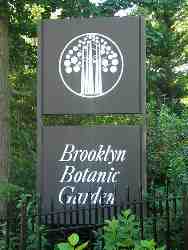
At the end of our summer holiday in the states of New York and Pennsylvania, we had to return to Kennedy Airport. This involved driving back through New York city. As usual in a large American city driving on busy freeways proved to be exhilarating and a bit tiring, as concentration is needed. Imagine my delight as a sign saying 'Brooklyn Botanic Garden' flashed past on our right. It was up the exit ramp and away to find this urban paradise. By taking a wrong turn and counting the streets wrongly, we managed a quick tour of Brooklyn, which if it were not part of New York City, would be the fourth largest city in the USA.
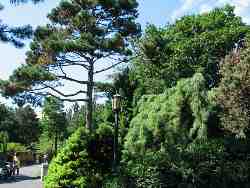

Brooklyn Botanic Garden with adjacent Prospect Park, are bounded on all sides by city streets, much more compact than the New York Botanic Garden in the Bronx. To find the entrance, we managed to circumnavigate the whole garden and Prospect Park. It was designed in 1910 by the Olmstead Brothers and contains features guaranteed to appeal to all gardeners and to anyone seeking a peaceful oasis in the busy city.
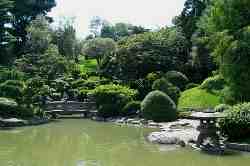
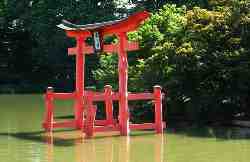
One of the favourite areas is a huge Japanese Garden complete with large pond filled with carp, a Tea House fine conifers and lots of Japanese 'furniture'. Indeed the garden has a particularly fine collection of conifers, which link and separate the various areas, while screening out the traffic noise and some of the building. The multicoloured carp and tiny 'turtles' are very popular with visitors. A fine heron stood motionless contemplating devouring a carp twice his size!

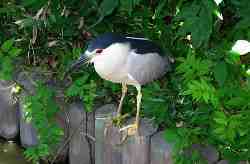
We were keen to find the rock garden. We realised that in July the plants would not be at their best but we would be able to appreciate the structure and forms of rocks, paths and the dwarf trees and shrubs. However the rock garden and native plant areas were about as far from our entrance as they could be. This meant we could linger by the lily ponds and herbaceous areas.
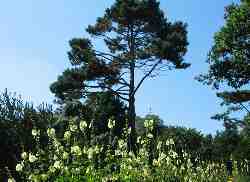
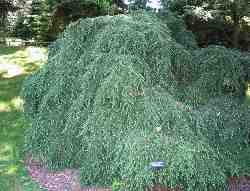
Bright sunshine, hot stone walls to sit on, water lilies and lotus blossoms and above them the tops of Brooklyn's brownstone apartments and tower blocks combine to make this a magical area. Tall Echinacea, hollyhocks, Monarda, lilies and Rudbeckia reached for the sunshine.
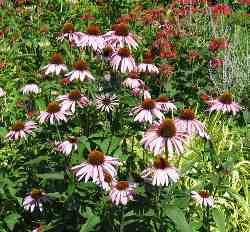
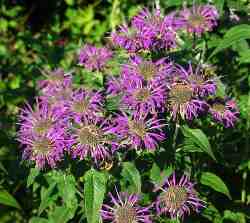
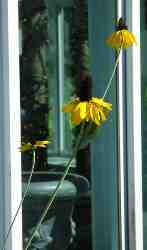
Hydrangeas are at their best in June and July and seem to relish the bright hot sunshine. Two splendid varieties which took my eye were Hydrangea macrocarpa 'BLUE WAVE' and Hydrangea arborescence 'ANNABELLE'.

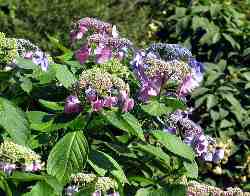
I was entranced by the Lotus flowers. While I well remember the water lilies [Nymphaea aquatica] growing in the formal pond in Falkland Palace gardens, I have rarely seen Lotus flowers and certainly never the white form.

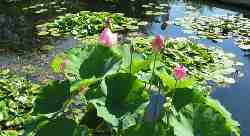

Lotus is a plant sacred to Hindus. All parts of it can be eaten. The rhizome can be boiled, pickled or candies. The seeds are used in Asian cooking. The leaves are used to alleviate sunstroke and the fruit pods to stop bleeding. For good measure fibres from the plant are woven into cloth. Buddha is often portrayed sitting on a Lotus flower.
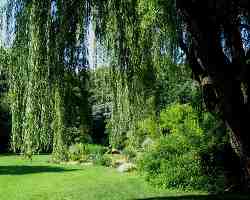
At last we crossed several lawns and came to the entrance to the rock garden, hidden under the cascading branches of a huge weeping willow. Enormous glacial boulders have been used to define the area and a winding path meanders round the rock garden. The boulders were part of the terminal moraine of the Wisconsin Ice Sheet which scoured North America 30,000 years ago. All the gardeners had to do was rearrange these boulders!
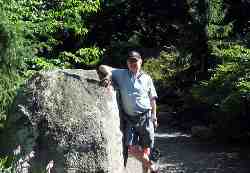
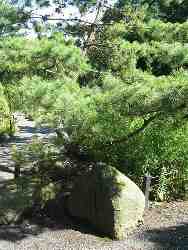
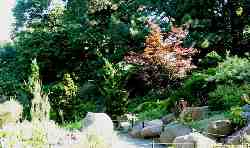
In mid summer it was easiest to appreciate the conifers, mainly pines. Surprisingly, Astilbes and Hostas seem to thrive in temperatures of over 100F. I had expected to see lots of different Hostas, as we are constantly being told that the Americans are hybridising and selecting dozens of variants every year but most were familiar to me from British gardens.
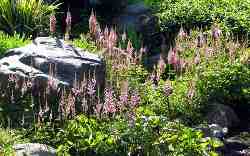

A nicely berried plant of Viburnum plicatum SHASTA coloured a shady bank beside ranks of hostas.

Hosta PIEDMONT GOLD provided good contrasting foliage colour.

Glaucous blue juniper berries put me in the mod for a nice cold gin and tonic, which I eventually got on the plane home.

A white and purple Antirrhinum soaked up the hot sunshine beside a large rock.

In the native plant area, the star plant was Lilium super bum, which we had admired several years ago along the Blue Ridge Highway in North Carolina and Virginia. Standing six feet tall and more it commands your attention.

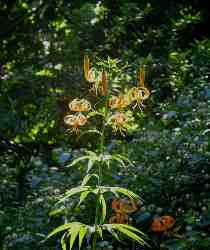
At the other end of the scale a small Opuntia humours displayed a few flowers. I was surprised to discover that Opuntias grow in all states except Alaska an Hawaii. I had thought of cactus as being plants of the deserts and dry western grasslands.
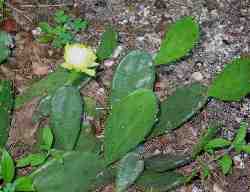
In fruit beside the Opuntia was a fine spike of Smilacina racemosa, a woodland plant related to Solomon's Seal which reminds of the late Joan and Don Stead's garden in Thorntonhall.
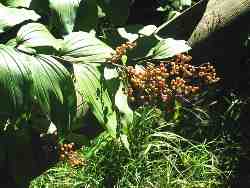
Out in the general garden here are island beds with selections of special plants. I likes Cleome hassleriana, with its untidy spidery pink flowers.

The Lily bed contains a mixture of true Liliums and day lilies, Hemerocallus. I suspect one could spend a lifetime making a collection of either of these.
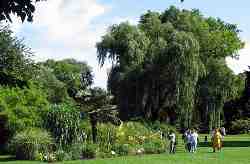
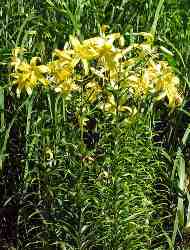

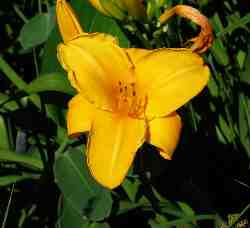
The tallest flowers were growing together. Inula magnifica from the Caucasus and Rudbeckia maxima from he Western USA are both composites with flowers of an identical yellow shade. In with them was a wild sunflower, Helianthus annuus. All three towered above our heads.

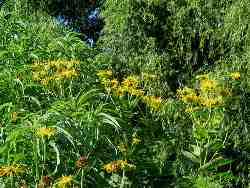

As you walk around this garden, the melange of deciduous and evergreen trees shelters you from the hot sun while the openings between them guide you from one group of treasures to the next.
As we passed under an ancient tree, I was so busy studying the gnarled bark that I missed the white racemes dangling above my hand. This was Pterocarya fraxinifolia known as the Caucaian Wingnut. It was growing on this site before the garden.

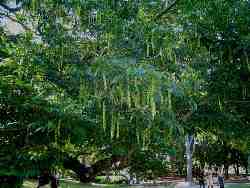
An avenue of scarlet oaks has been 'planted in remembrance of the events of September 11th 2001.and to those who lost their lives that day.'

I read that in spring and early summer flowering cherries and magnolias delight visitors. There is a Fragrance garden with plant signs in Braille. Just how someone with poor or no sight finds the signs I have no idea but the plants here are in raised beds. They have been chosen for their fragrance and texture.

On this hot Saturday in July we counted at least six wedding parties choosing different areas for their formal wedding pictures. The garden is obviously popular with the residents of Brooklyn.
duck n ducklings.jpg
If you have time to spare on your journey to or from Kennedy Airport, take the opportunity to visit this urban horticultural treasure trove. And ….. HAVE A NICE DAY!
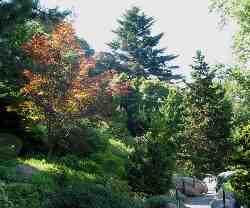
^ back to the top ^
|

